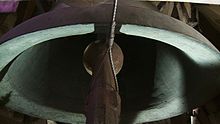Night singing

Night singing is the name for making music with church bells . It can only be practiced if bells can be decoupled from today's electrical controls. Music is made with the help of hands and feet. The bells are placed in a harness made of ropes and straps so that they can be used to make music.
Night singing in Gütersloh

In Germany, the nocturnal chimes are only heard in Gütersloh in the Martin Luther Church . According to traditional rules, rhythms and melodies are rung with hands and feet by pulling, hitting and letting go. A total of three bells are ringed in Gütersloh.
The nocturnal chime is a bell that originated centuries ago; it has been proven that it has been played in Gütersloh since 1790. Since then, it has been chimed in its six different parts or movements as it is today, in which, among other things, the beeping occurs in the third and fifth parts. In the overall framework of the bells it has a share of approx. 30%. The duration of the bells including the necessary modification phases on the bells is ¾ hour.
The bell is only rung in winter, from Reformation Day (October 31) to Candlemas every Saturday from 7 p.m., as well as on Christmas holidays and New Year's Eve .
Differentiation to beers
There is a difference between the Gütersloh Nachtsang bell and the so-called Beiern , which is still rung today not only in the Rhineland. The night singing peal originated about 1000 years ago. It was rung at cathedrals and churches, especially in the Osnabrück region, according to oral tradition. Written evidence has existed since 1790.
The special thing about night singing is the melody and the set chords. In the first and second part the tone of voice rises slowly and is played over 15 to 20 minutes with different melodies. In the fourth and sixth parts, longer melody passages complement each other. The bell consists of six parts in total. The section called 'Adam', the sixth part, is only played on New Year's Eve. The other parts are not labeled, just numbered. The total duration of the bells is 45 minutes. In the third and fifth part there is a smaller bell that lasts 5 minutes and 4 minutes. The other four parts are much longer and give the carillon the actual character of the night singing through the different melodies.
Say
The chimes were supposedly introduced by bishops who got lost during the night. Since it helped them to find their way back, it should serve, especially in autumn and winter, so that all people can use this help in case they got lost. There are two legends about tradition:
The first legend goes from the rescue of a bishop with official residence in the Osnabrück region. After a hunt with a small retinue, the group got lost in the forest and their strength quickly waned due to the cold. A bell signal was the sign of rescue. The bishop followed the bell and was saved.
The second legend is based on the rescue of a bishop, only this time near the coast. Here, too, there was a bell that night, which led a stray bishop back home.
Individual evidence
- ↑ Gerhard Schabbon: Christmas Symphony of the bells . In: Gütersloh Christmas through the ages. 3rd Edition, 1981, pp. 9-11.
- ↑ Hans-Dieter Musch: The bell saved the bishop . In: Gütersloh Christmas through the ages. 3rd edition, 1981, pp. 12-15.
Web links
- nachtsanggelaeut.de - All information about the past and present of the Nachtsang bell in Gütersloh and Europe
- [1] - Video about the variety of night singing in the bell tower of the Martin Luther Church in Gütersloh.
- [2] Regina Bojak in the daily newspaper "Die Glocke" on February 13, 2013
Coordinates: 51 ° 54 ′ 21.1 ″ N , 8 ° 22 ′ 44.1 ″ E
